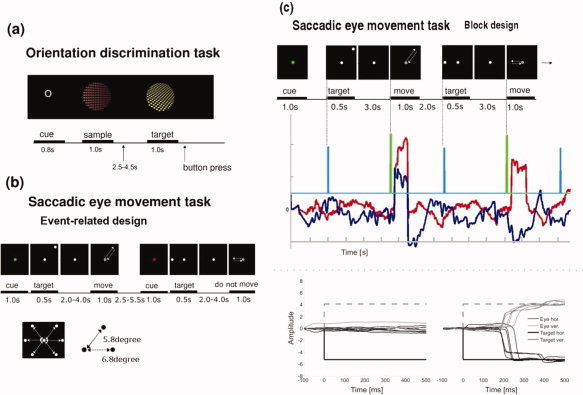Figure 1.

Paradigm as employed in the study. Experiment 1 (a) employed a surface orientation discrimination task in a delayed matching to sample paradigm. Stimuli were presented at the centre of the screen. The cue was followed by a sample stimulus. After the sample stimulus, a single matching stimulus was presented. Subjects were instructed to press the left button with their right index finger when the stimulus showed the same orientation (task O) or the same color (task C) as the sample and the right button with the middle finger when the matching stimulus was different. Subjects responses were recorded by index or forefinger button press. Stimuli were presented for 1,000 ms with a stimulus onset asynchrony randomised between 2,500 and 4,500 ms. Experiment 2 (b) was an event‐related ‘go – no go’ memory guided saccadic eye movement task. The event condition was cued to the subject by a red or green cue at trial onset, event structure was then identical. The inset shows the six possible target points at the points of a virtual hexagon. Distance from central fixation to target were 5.8 degree in diagonal and 6.8 degree in horizontal plane. (c) Saccadic eye movement data from one subject. Top panel shows two ‘go’ trials from the block designed ‘go – no go memory guided saccade’ experiment. In the middle row, eye movement recordings of the two trials are shown (red: horizontal eye movement, dark blue: vertical eye movement, light blue: time of ‘target onset’, green: onset of ‘move’ cue). The bottom panel shows all data for each eye movement to the upper left target (4 events) for one subject in one session. [Color figure can be viewed in the online issue, which is available at www.interscience.wiley.com.]
